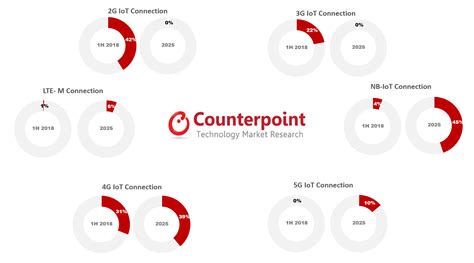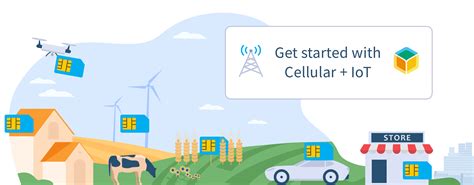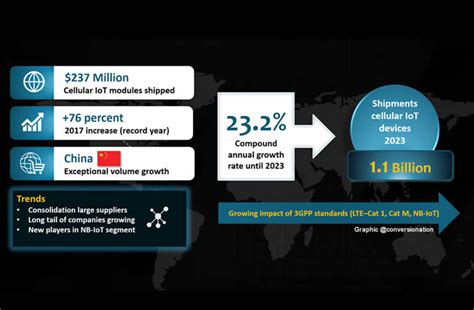Overview of Cellular IoT
Cellular IoT refers to the use of cellular network technologies to connect physical devices and objects to the internet, enabling them to collect and exchange data. The main cellular technologies used for IoT are:
| Technology | Description |
|---|---|
| 2G | Legacy cellular networks like GSM and CDMA, offering low data rates but wide coverage |
| 3G | Evolved 2G networks with higher data rates, e.g. UMTS and EVDO |
| 4G LTE | High-speed mobile broadband with lower latency and improved spectrum efficiency |
| 5G | Next-generation networks promising gigabit speeds, ultra-low latency, and massive device density |
| LTE-M | Low-power wide-area (LPWA) variant of 4G optimized for IoT, offering extended coverage and battery life |
| NB-IoT | Narrowband radio technology in licensed spectrum that enables wide area coverage and long device battery life |
The choice of cellular technology for an IoT application depends on factors such as bandwidth requirements, power constraints, deployment environment, and cost. 2G and 3G are still used for legacy IoT devices, while 4G LTE and emerging 5G networks offer higher performance and capacity. LPWA technologies like LTE-M and NB-IoT are designed specifically for low-bandwidth, low-power IoT use cases.
Benefits of Cellular IoT
Using cellular networks for IoT has several key advantages:
Wide Area Coverage
Cellular networks already cover most populated areas of the world, making it possible to deploy connected devices almost anywhere. Devices can connect to the nearest cell tower to transmit data.
Scalability
Cellular networks are designed to support very large numbers of devices. As IoT deployments grow in scale, cellular can provide the capacity needed.
Mobility
Cellular enables connectivity to moving objects such as vehicles, assets, or wearables. Devices can seamlessly switch between cell towers as they move.
Low Power Consumption
LPWA cellular technologies like LTE-M and NB-IoT are optimized for low power, allowing devices to operate for years on a single battery charge. This is critical for remote IoT sensors and devices.
Security
Cellular networks have built-in security features like encryption and authentication to protect data privacy and prevent unauthorized access. Additional end-to-end security mechanisms can be layered on top.
Managed Service
Cellular connectivity is provided as a managed service by mobile network operators, with guaranteed quality of service, technical support, and device management tools. This reduces complexity for IoT adopters.

Cellular IoT Applications
Cellular IoT is being adopted across a wide range of industries and use cases, such as:
| Application | Examples |
|---|---|
| Asset Tracking | Monitoring location and status of vehicles, equipment, or inventory using GPS and sensors |
| Smart Cities | Connecting infrastructure like streetlights, parking meters, waste bins, and air quality sensors |
| Agricultural Monitoring | Tracking soil moisture, temperature, and crop health to optimize farming operations |
| Healthcare | Remote patient monitoring, telemedicine, and wearable health devices |
| Industrial Automation | Connecting machines, robots, and control systems in factories, warehouses, and supply chains |
| Smart Metering | Automated reading and control of utility meters for electricity, gas, and water |
| Wearables | Smartwatches, fitness trackers, personal safety devices, and pet trackers |
The flexibility and ubiquity of cellular networks make them suitable for a diverse range of IoT solutions across consumer and industrial markets. Analysts predict that cellular IoT connections will reach 3.5 billion by 2023.

Challenges of Cellular IoT
While cellular offers many benefits for IoT, there are also some challenges to consider:
Cost
Cellular data plans and hardware can be more expensive compared to other IoT connectivity options like Wi-Fi or LPWA alternatives. Careful design is needed to minimize data consumption and optimize costs.
Battery Life
Although LPWA technologies have made progress in reducing power consumption, cellular still requires more energy than some other IoT protocols. Devices may need larger batteries or energy harvesting mechanisms.
Global Deployment
Cellular networks and regulations vary between countries and regions, which can complicate global IoT deployments. Roaming agreements and specialized SIMs may be required to enable seamless cross-border operation.
Indoor Coverage
Cellular signals can be attenuated by buildings and obstacles, making indoor coverage a challenge for some use cases. This may require installation of small cells, repeaters, or fallback to other connectivity methods.
Legacy Devices
Many existing IoT devices were designed for 2G and 3G networks which are now being phased out in some markets. Migrating these legacy devices to newer technologies like 4G and 5G may require hardware upgrades or replacement.

Future of Cellular IoT
The cellular IoT ecosystem is continuing to evolve with new technologies and deployment models to meet the growing demands of connected devices.
5G IoT
The introduction of 5G networks promises to be a major enabler for IoT, with support for massive numbers of devices, ultra-low latency, and high-speed connectivity. 5G will unlock new possibilities such as real-time industrial control, autonomous vehicles, and immersive experiences.
eSIM and iSIM
Embedded SIM (eSIM) and integrated SIM (iSIM) technologies allow IoT devices to be provisioned and managed remotely, without the need for physical SIM cards. This simplifies manufacturing and deployment, and enables dynamic network switching for global connectivity.
Edge Computing
Processing and analyzing IoT data closer to the source, at the network edge, can reduce latency and bandwidth requirements. Cellular networks are evolving to support edge computing, with initiatives like Multi-access Edge Computing (MEC) to host applications and services at the radio access network.
Private Cellular Networks
Enterprises are increasingly deploying their own private cellular networks to support IoT and other applications, using dedicated spectrum and infrastructure. This provides greater control, security, and performance compared to relying on public networks.
Satellite IoT
The convergence of cellular and satellite networks is enabling IoT connectivity in remote and underserved areas. Satellites can provide backhaul for cellular base stations, or directly connect to IoT devices using low-earth orbit constellations like Starlink or narrowband technologies like Inmarsat’s BGAN.
Conclusion
Cellular networks are a key enabler for the Internet of Things, providing reliable, secure, and scalable connectivity for billions of devices. With a range of technologies to suit different use cases and the ongoing evolution towards 5G and beyond, cellular is well-positioned to support the growth of IoT across industries. As the ecosystem matures, we can expect to see even more innovative applications and business models emerge, transforming the way we live and work.
FAQ
What is the difference between LTE-M and NB-IoT?
LTE-M and NB-IoT are both LPWA technologies designed for IoT, but they have some differences in terms of bandwidth, latency, and power consumption. LTE-M offers higher data rates (up to 1 Mbps) and lower latency, making it suitable for applications that require real-time communication or voice support. NB-IoT is more optimized for low-bandwidth, infrequent data transmission, and can support even longer battery life and deeper indoor coverage. The choice between the two depends on the specific requirements of the IoT use case.
Can cellular IoT devices roam between different countries?
Yes, cellular IoT devices can roam between countries, but it requires proper planning and support. Devices need to be equipped with the appropriate frequency bands and certifications for the target markets, and the IoT service provider needs to have roaming agreements in place with operators in those countries. eSIM and global SIM solutions can help simplify international roaming for IoT devices.
How secure is cellular IoT?
Cellular networks have several built-in security features, such as SIM-based authentication, encryption of over-the-air traffic, and secure key storage. However, end-to-end security also requires proper implementation at the device and application levels, such as using secure boot, encrypted storage, and secure communication protocols. Cellular IoT security can be further enhanced with techniques like virtual private networks (VPNs), private APNs, and zero-trust architectures.
What is the typical battery life for a cellular IoT device?
The battery life of a cellular IoT device depends on several factors, including the specific cellular technology used (e.g. LTE-M vs. NB-IoT), the frequency and size of data transmissions, and the device’s power management techniques. In general, LPWA technologies like LTE-M and NB-IoT are designed to enable battery life of several years (up to 10+ years in some cases) for low-bandwidth, infrequent communication scenarios. However, devices that require frequent data transmission or always-on connectivity may have shorter battery life.
How do I choose the right cellular technology for my IoT application?
Choosing the right cellular technology for an IoT application requires careful consideration of several factors, such as:
- Data throughput and latency requirements
- Power consumption and battery life constraints
- Coverage and mobility needs
- Deployment environment (indoor vs. outdoor, urban vs. rural)
- Regulatory and certification requirements
- Cost and availability of devices and services
In general, LPWA technologies like LTE-M and NB-IoT are well-suited for low-bandwidth, low-power, and wide-area IoT applications, while 4G LTE and 5G are better for high-performance, low-latency use cases. It’s important to work with experienced IoT solution providers and network operators to assess the specific needs of your application and select the most appropriate technology stack.

No responses yet